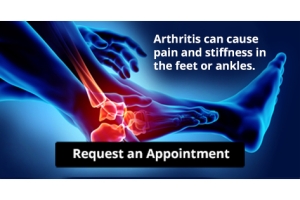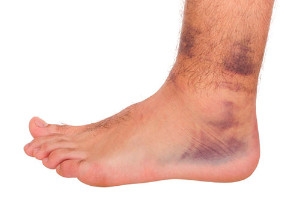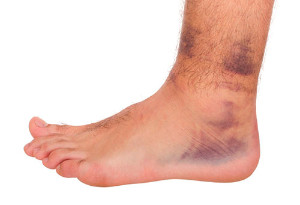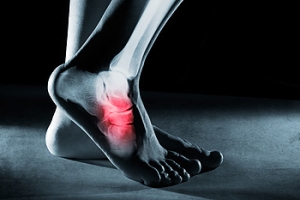
Runners and Walkers Have Different Needs in Shoes
 There are known differences between walking and running shoes. The type of shoes that runners typically prefer consist of having additional flexibility, which is needed as a result of strong impact on the ground. People who enjoy walking may benefit from footwear with less padding in the heel and arch areas of the feet. Additionally, walking shoes can offer more support than running shoes. They have firmer soles which may help to make walking more comfortable. If you are interested in learning about additional details of the differences between walking and running shoes, please consult with a podiatrist.
There are known differences between walking and running shoes. The type of shoes that runners typically prefer consist of having additional flexibility, which is needed as a result of strong impact on the ground. People who enjoy walking may benefit from footwear with less padding in the heel and arch areas of the feet. Additionally, walking shoes can offer more support than running shoes. They have firmer soles which may help to make walking more comfortable. If you are interested in learning about additional details of the differences between walking and running shoes, please consult with a podiatrist.
For more information about walking shoes versus running shoes, consult with John McGhan, DPM from Gold Canyon Foot & Ankle. Our doctor can measure your feet to determine what your needs are and help you find an appropriate pair of footwear.
Foot Health: The Differences between Walking & Running Shoes
There are great ways to stay in shape: running and walking are two great exercises to a healthy lifestyle. It is important to know that running shoes and walking shoes are not interchangeable. There is a key difference on how the feet hit the ground when someone is running or walking. This is why one should be aware that a shoe is designed differently for each activity.
You may be asking yourself what the real differences are between walking and running shoes and the answers may shock you.
Differences
Walking doesn’t involve as much stress or impact on the feet as running does. However, this doesn’t mean that you should be any less prepared. When you’re walking, you land on your heels and have your foot roll forward. This rolling motion requires additional support to the feet.
Flexibility – Walking shoes are designed to have soft, flexible soles. This allows the walker to push off easily with each step.
If you have any questions, please feel free to contact our office located in Gold Canyon, AZ . We offer the newest diagnostic and treatment technologies for all your foot care needs.
Walking Shoes vs. Running Shoes
Although walking shoes and running shoes look similar, they have characteristics that make them different from each other. Runners should avoid running in walking shoes and vice versa. It is very important that you wear the proper footwear for the activity you are going to partake in, for you to avoid injury.
If you are looking to buy a new pair of running shoes, there are certain things you should look out for. One of the main components that makes up a good running shoe is flexibility. You should be able to bend and flex the forefoot of the shoe that you are purchasing. If you can bend the entire shoe in half with ease, this is a sign that the shoe does not have enough structure for your feet. Another feature you should look for is a low heel. Certain running shoes have a low heel to support runners who land on the ball of their feet. Lastly, you should look for the fit of the running shoe. You should visit the best running shoe store in your area to have your feet properly sized for the shoes in the store. Usually, the staff will be able to help recommend the best type of running shoe for your needs.
When you are walking, the body’s weight is evenly distributed on the foot. This influences the design of shoes made for walking. If you are looking to buy a pair of walking shoes, there are different features you should look for to determine which pair of shoes is best for you. Walking shoes should be flexible through the ball of the foot to allow for a greater range of motion through the roll of the forefoot. These shoes also should have greater arch support for the foot. If you plan on walking long distances or on hard surfaces, it is best that you wear shoes that have cushioning.
When trying on a new pair of shoes, the heel should fit snugly without slip. You should shop for shoes after a long walk, since your feet tend to swell throughout the day. Many people have one foot that is a different size than the other, so it is best that you have both feet measured when looking for your true size. You should also beware that sizes vary depending on the shoe brand. A certain size in one brand may be a different size in a different brand. Lastly, you should always walk around in shoes that you plan on buying. This will help you determine whether the shoes are comfortable and if they fit well on your feet.
Always look for good shoe construction when shopping for new sneakers. The upper part of the shoe should allow for adjustment through laces or straps. If you need help with shoe sizing or if you need custom orthotics for your feet, you should make an appointment with your podiatrist for assistance. He or she will be more than happy to help you with your shoe sizing needs.
Habits That May Lead to Foot Fatigue While Working
 Patients who stand or walk for the majority of the working day may notice aches and pains in their feet. This type of pain can include cramps, sore heels and arches, in addition to swollen ankles. The reasons why foot pain may occur can include having flat feet, wearing shoes that do not fit correctly, or it may happen as a result of weight gain. Patients who sit for extended periods of time at a computer desk may have developed habits that can lead to foot fatigue. These can include crossing the ankles, resting on the balls of the feet, in addition to sitting on top of one foot. There are foot stretches that can be performed while working during the day. If you would like information on how this is achieved, please schedule a consultation with a podiatrist.
Patients who stand or walk for the majority of the working day may notice aches and pains in their feet. This type of pain can include cramps, sore heels and arches, in addition to swollen ankles. The reasons why foot pain may occur can include having flat feet, wearing shoes that do not fit correctly, or it may happen as a result of weight gain. Patients who sit for extended periods of time at a computer desk may have developed habits that can lead to foot fatigue. These can include crossing the ankles, resting on the balls of the feet, in addition to sitting on top of one foot. There are foot stretches that can be performed while working during the day. If you would like information on how this is achieved, please schedule a consultation with a podiatrist.
While working on the feet, it is important to take the proper care of them. For more information about working on your feet, contact John McGhan, DPM from Gold Canyon Foot & Ankle. Our doctor will treat your foot and ankle needs.
Working on Your Feet
Standing on your feet for long periods of time can cause stress and pain in your feet. Your whole body may experience change in terms of posture, back pain, bunions, callouses and or plantar warts. There are ways to avoid these conditions with proper foot care, smart choices and correct posture.
Positive Changes
Negative heeled shoe – Choosing this shoe type places the heel slightly lower than the ball of the foot. These are great for overall foot health. Find shoes that fit you correctly.
Go barefoot – Our feet were not designed to be enclosed for all hours of the day. Try to periodically expose your feet to air.
Eliminate Pain
Foot Exercises – Performing simple exercises, incorporating yoga and doing stretches are beneficial. This will allow increased blood flow to the area and muscles of the foot.
Achilles tendon – Stretching the foot out flat on the floor will relax the calf muscles and tendon. These exercises can be performed almost anywhere. Make sure you add these exercises to your daily regimen.
With a little bit of this information and knowing more about foot health, you will notice changes. Foot stretches and proper footwear will help with pain and prevent further issues.
If you have any questions please feel free to contact our office located in Gold Canyon, AZ . We offer the newest diagnostic and treatment technologies for all your foot and ankle needs.
How to Handle a Long Work Day on Your Feet
In 2014, the American Podiatric Medical Association surveyed 1,000 American adults and found that half of all respondents lived with foot pain. Fortunately, there are ways to avoid foot problems such as following a daily footcare routine and wearing proper footwear at work.
If you have a job that requires you to be on your feet, it is best that you do not wear flat sole shoes. Your heel should be slightly elevated (less than 2 inches, but at least ¼-inch) if you are going to be standing for a prolonged period. You should also make sure that the shoes you wear are not too small. Tight shoes may cut off circulation to your feet, which will result in pain and blisters. It is always best to purchase fitted shoes later in the day, because the feet tend to swell as the day progresses. It may also be helpful to buy shoes a half size larger if you plan on wearing custom orthotics or arch supports.
Your muscles may become stiff when you are constantly standing up. It is important to take breaks every hour to stretch and relax. One tip is to perform calf raises, because this exercise will help improve your circulation. To perform this stretch, you first need to stand on the edge of a step with your abdominal muscles pulled inward. You then need to grip the step with the balls of your feet with your heels hanging over the edge. Next, try to raise your heels above the step by a few inches while standing on your tiptoes; hold this pose for a second. You should then lower your heels back even to the platform. These calf raises should be done ten times for full effectiveness.
You should also take care of your feet while you are at home. One of the best ways to prepare your feet for a long day of work is to soak them in ice water. Doing so for 20 minutes will help fight the swelling and inflammation that results from being on your feet at work.
Nevertheless, if you are experiencing pain in your feet, you should seek help from your podiatrist. Your doctor will help treat any ailments you may have in addition to helping you prevent any other ailments from developing in the future.
Arthritis Can Cause Pain in the Feet and Ankles
Who Is Prone to Foot and Ankle Injuries?
Maximum stability and mobility in the body can be attained when the feet and ankles work properly together. Foot and ankle trauma is a common ailment among people worldwide and may commonly happen among athletes. Some of the injuries people may develop from participating in running and jumping activities can consist of Achilles tendon injuries, ankle sprains, or stress fractures. Symptoms of an Achilles tendon injury can include pain in the bottom of the calf, and it may be difficult to point and flex the foot. An ankle sprain can occur when the ligaments are stretched beyond normal capacity, and the foot may become swollen and difficult to walk on. Stress fractures can be referred to as hairline fractures and can develop as a result of overuse while frequently running. If you have any pain in your feet or ankles, please schedule an appointment with a podiatrist as quickly as possible.
Foot and ankle trauma is common among athletes and the elderly. If you have concerns that you may have experienced trauma to the foot and ankle, consult with John McGhan, DPM from Gold Canyon Foot & Ankle. Our doctor will assess your condition and provide you with quality foot and ankle treatment.
Foot and ankle trauma cover a range of injuries all over the foot; common injuries include:
- Broken bones
- Muscle strains
- Injuries to the tendons and ligaments
- Stress fractures
Symptoms
Symptoms of foot and ankle injuries vary depending on the injury, but more common ones include:
- Bruising
- Inflammation/ Swelling
- Pain
Diagnosis
To properly diagnose the exact type of injury, podiatrists will conduct a number of different tests. Some of these include sensation and visual tests, X-rays, and MRIs. Medical and family histories will also be taken into account.
Treatment
Once the injury has been diagnosed, the podiatrist can than offer the best treatment options for you. In less severe cases, rest and keeping pressure off the foot may be all that’s necessary. Orthotics, such as a specially made shoes, or immobilization devices, like splints or casts, may be deemed necessary. Finally, if the injury is severe enough, surgery may be necessary.
If you have any questions, please feel free to contact our office located in Gold Canyon, AZ . We offer the newest diagnostic and treatment technologies for all your foot care needs.
Foot and Ankle Trauma
The foot and ankle area works with 26 bones, 33 joints, and more than 100 different muscles, tendons, and ligaments. Problems with any parts of this network can result in some kind trauma within the foot and ankle area. Most foot and ankle trauma is a result of aging or intense activities such as sports. However, trauma in this area can also be the result of simple things such as wearing heels too much or even walking on an uneven pavement. There are several kinds of symptoms related to specific injuries, and there are also several different treatments that could be used as well.
Foot Injuries and Symptoms
Some common injuries in the feet include stress fractures and bunions. Stress fractures are small cracks in a bone or severely bruised parts of the bone. This type of injury is caused by intense and repetitive activity, which is found in actions involved with sports and exercise. Symptoms of this injury include pain, swelling, tenderness, and possible bruising. Another common injury with bones is also bunions, which are bony bumps typically formed on the big and little toes. This injury is typically a result from wearing high heels and unfit shoes. Some common symptoms are swelling around the big and little toe areas, as well as pain and restricted movement.
Ankle Injuries and Symptoms
The common injuries associated with ankle trauma consist of sprains, strains, and fractures. These injuries are defined by the type of tissue that has been damaged. Fractures are breaks within the bones caused by sudden impacts to the area. Sprains relate to any damage of the ligaments, commonly caused by being stretched beyond their normal range of motion. Strains are attributed to damage of the muscles and tendons from being pulled too far. Symptoms of these injuries include severe pain, limited range of motion, and swelling.
Diagnosis and Treatment
Since there are several types of injuries with a variety of symptoms, it is important to see a podiatrist about your condition. Podiatrists can run a variety of tests to diagnose an injury accurately. This includes physical examinations, X-rays, or MRIs. A podiatrist may even run a stress test, which is an X-ray taken while pressure is applied to the damaged area. Once your injury has been diagnosed, the doctor may have you wear a cast or a splint, or gradually develop your range of motion. Severe injuries may require physical therapy or even surgery if necessary. If you have any concerns from past foot and ankle trauma experiences, consult with John McGhan, DPM from Gold Canyon Foot & Ankle. Our doctor can assess your condition and provide you with quality foot and ankle treatment.
If you have any questions, please feel free to contact our office located in Gold Canyon, AZ . We offer the newest diagnostic and treatment technologies for all your foot care needs.
Painful Plantar Fasciitis
 Located on the bottom of the foot, there is a large portion of tissue that connects the heel to the toes. This is known as the plantar fascia, and if it becomes inflamed, the condition known as plantar fasciitis may develop. This condition can occur for a variety of reasons. These can include standing for extended periods of time throughout the day on a hard surface, participating in running or jumping activities, or from wearing shoes that do not fit correctly. Common symptoms that are often associated with plantar fasciitis can include swelling, severe pain after arising in the morning, and it may be difficult to walk. You may find relief when proper foot stretches are performed, and when the affected foot is elevated, as this may help to diminish existing swelling. It is suggested that you consult with a podiatrist if you experience any symptoms of plantar fasciitis.
Located on the bottom of the foot, there is a large portion of tissue that connects the heel to the toes. This is known as the plantar fascia, and if it becomes inflamed, the condition known as plantar fasciitis may develop. This condition can occur for a variety of reasons. These can include standing for extended periods of time throughout the day on a hard surface, participating in running or jumping activities, or from wearing shoes that do not fit correctly. Common symptoms that are often associated with plantar fasciitis can include swelling, severe pain after arising in the morning, and it may be difficult to walk. You may find relief when proper foot stretches are performed, and when the affected foot is elevated, as this may help to diminish existing swelling. It is suggested that you consult with a podiatrist if you experience any symptoms of plantar fasciitis.
Plantar fasciitis can be very painful and inconvenient. If you are experiencing heel pain or symptoms of plantar fasciitis, contact John McGhan, DPM from Gold Canyon Foot & Ankle. Our doctor can provide the care you need to keep you pain-free and on your feet.
What Is Plantar Fasciitis?
Plantar fasciitis is the inflammation of the thick band of tissue that runs along the bottom of your foot, known as the plantar fascia, and causes mild to severe heel pain.
What Causes Plantar Fasciitis?
- Excessive running
- Non-supportive shoes
- Overpronation
- Repeated stretching and tearing of the plantar fascia
How Can It Be Treated?
- Conservative measures – anti-inflammatories, ice packs, stretching exercises, physical therapy, orthotic devices
- Shockwave therapy – sound waves are sent to the affected area to facilitate healing and are usually used for chronic cases of plantar fasciitis
- Surgery – usually only used as a last resort when all else fails. The plantar fascia can be surgically detached from the heel
While very treatable, plantar fasciitis is definitely not something that should be ignored. Especially in severe cases, speaking to your doctor right away is highly recommended to avoid complications and severe heel pain. Your podiatrist can work with you to provide the appropriate treatment options tailored to your condition.
If you have any questions please feel free to contact our office located in Gold Canyon, AZ . We offer the newest diagnostic and treatment technologies for all your foot and ankle needs.
Plantar Fasciitis
The plantar fascia is a connective tissue in the heel that stretches across the bottom length of your foot. Plantar fasciitis occurs when the connective tissue becomes inflamed, causing heel pain and discomfort during physical activity. Although the condition is completely treatable, traditional methods can take up to a year to start becoming effective.
Plantar fasciitis is caused by a number of everyday activities, so understanding the condition is important for managing and treating it. One of the most common causes of plantar fasciitis is excessive running, especially with improper fitting or non-supportive shoes. Too much exercise can lead to the plantar fascia being overworked and overstretched, which can cause tears in the tissue. Along with improper fitting shoes, pronation, the rolling of the feet inward, is a common cause of plantar fasciitis. If not treated properly, the plantar fascia becomes overstretched and starts to tear, causing inflammation.
Despite the common causes of plantar fasciitis, there are many different treatment options. For less severe cases, conservative home remedies include taking anti-inflammatory drugs to alleviate pain, applying ice packs to the bottom of your foot and heel, slowly stretching and exercising your feet to re-strengthen the tissue, and using orthotic devices are all ways to help manage your plantar fasciitis.
For more severe cases, shockwave therapy has become a common solution for plantar fasciitis. Shockwave therapy can effectively break up the tissue on the bottom of your foot which facilitates healing and regeneration. This fights the chronic pain caused by plantar fasciitis. Even if this doesn’t work, surgery is always a final option. Surgery on the tissue itself can be done to permanently correct the issue and stop the inflammation and pain in your heels.
No matter what the case may be, consulting your podiatrist is the first and best step to recovery. Even the slightest amount of heel pain could be the first stage of plantar fasciitis. Untreated symptoms can lead to the tearing and overstretching of tissue. Because the tearing of tissue can be compounded if it remains ignored, it can evolve into a severe case. The solution is early detection and early treatment. Talk to your podiatrist about the possibilities of plantar fasciitis if you’re experiencing heel pain.
Who Is Prone to Cuboid Syndrome?
 The pain that is associated with cuboid syndrome is generally felt on the outer side of the foot. This condition is known to be common among ballet dancers and athletes, and can develop due to performing repetitive movements. Additionally, it may occur from having had a foot injury, such as stepping off a curb unexpectedly, or twisting your ankle. Symptoms of this condition can include redness surrounding the point of injury, swelling in the ankle, and you may experience difficulty walking or moving the toes. Patients have found mild relief when the affected foot is elevated, as this may be helpful in reducing a portion of the swelling. If you feel you have cuboid syndrome, it is suggested that you consult with a podiatrist who can prescribe you custom orthotics, which may be beneficial in facilitating a speedy recovery.
The pain that is associated with cuboid syndrome is generally felt on the outer side of the foot. This condition is known to be common among ballet dancers and athletes, and can develop due to performing repetitive movements. Additionally, it may occur from having had a foot injury, such as stepping off a curb unexpectedly, or twisting your ankle. Symptoms of this condition can include redness surrounding the point of injury, swelling in the ankle, and you may experience difficulty walking or moving the toes. Patients have found mild relief when the affected foot is elevated, as this may be helpful in reducing a portion of the swelling. If you feel you have cuboid syndrome, it is suggested that you consult with a podiatrist who can prescribe you custom orthotics, which may be beneficial in facilitating a speedy recovery.
Cuboid syndrome, also known as cuboid subluxation, occurs when the joints and ligaments near the cuboid bone in the foot become torn. If you have cuboid syndrome, consult with John McGhan, DPM from Gold Canyon Foot & Ankle. Our doctor will assess your condition and provide you with quality foot and ankle treatment.
Cuboid syndrome is a common cause of lateral foot pain, which is pain on the outside of the foot. The condition may happen suddenly due to an ankle sprain, or it may develop slowly overtime from repetitive tension through the bone and surrounding structures.
Causes
The most common causes of cuboid syndrome include:
- Injury – The most common cause of this ailment is an ankle sprain.
- Repetitive Strain – Tension placed through the peroneus longus muscle from repetitive activities such as jumping and running may cause excessive traction on the bone causing it to sublux.
- Altered Foot Biomechanics – Most people suffering from cuboid subluxation have flat feet.
Symptoms
A common symptom of cuboid syndrome is pain along the outside of the foot which can be felt in the ankle and toes. This pain may create walking difficulties and may cause those with the condition to walk with a limp.
Diagnosis
Diagnosis of cuboid syndrome is often difficult, and it is often misdiagnosed. X-rays, MRIs and CT scans often fail to properly show the cuboid subluxation. Although there isn’t a specific test used to diagnose cuboid syndrome, your podiatrist will usually check if pain is felt while pressing firmly on the cuboid bone of your foot.
Treatment
Just as the range of causes varies widely, so do treatments. Some more common treatments are ice therapy, rest, exercise, taping, and orthotics.
If you have any questions, please feel free to contact our office located in Gold Canyon, AZ . We offer the newest diagnostic and treatment technologies for all your foot care needs.








